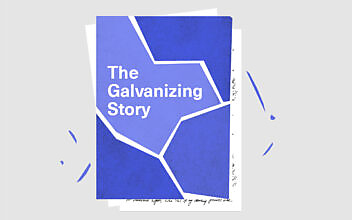For Velocity, the best B2B marketing starts with a great Galvanizing Story. And the first step in every Galvanizing Story is ‘the change in the world’.
But what happens when the world changes again?
We’re on the precipice of what may be a generation-defining recession. Rapidly evolving external conditions are casting established stories in a new light. So what do you do? Tweak key pieces to fit the new context? Turn the dials up and down on existing elements? Tear everything up and start again?
Contracting financial markets invite new scrutiny to established ideas, and it won’t be long before even the most rock-solid Galvanizing Stories are challenged by anxious internal stakeholders.
Now’s the time to prepare for those conversations. It’s not about battening down the hatches and waiting people out. It’s about being the stabilizing, confident marketer in the room that can help the business unpack its thinking and separate smart pivots from impulsive mistakes.
—
Now, this blog post isn’t an exhaustive list of every objection you’ll face. But we’ve been doing this long enough to see the biggest threats to a good Galvanizing Story a mile off.
So to help you prepare for the anxiety-driven conversations likely coming your way, here are some of the most common knee-jerk pivots—and how to handle them.
Mistake 1: Only talking about why you’re cool
A Galvanizing Story is broken down into five sections: the change in the world, the new potential, the obstacle, the breakthrough, and the pay-off.
All of the sections are important.
But when the budgetary clouds gather, some businesses deprioritize key sections (like ‘the change in the world’ and ‘the new potential’) in a rush to get to ‘the breakthrough’ aka, the bit where their business enters as the hero.
This can lead to decisions that make your Galvanizing Story look like this:

If you skip to your hero’s entrance without proving why your audience should care, you’re just a bleating loudmouth—and who wants to engage with that?
‘The change in the world’ is your chance to meet your audience where they are. To align yourself with the hopes and fears of your target personas going through this change and how it impacts their working lives day to day—don’t pass that up.
There will be a time and place for you to communicate why a prospect should trust you and what’s so brilliant about your business. In fact, it’s vital that there is. But if this is all (or even nearly all) you’re doing, you’re wasting that great Galvanizing Story you worked so hard to create.
In times of recession, you need your campaigns to hit your audience in the feels. Because you’re not just asking them to part with their money (like you do in less turbulent times), you’re asking them to agree that their money is better spent on your services than as collateral in their coffers.
In short, they won’t believe in the outcomes you’re promising (or in your ability to deliver them) if you skip the part where you prove both are real.
Mistake 2: Turning a conversation into a lecture
On the other side, there are businesses who contract verbal diarrhea when times get tough.
Suddenly, their nuanced Galvanizing Story becomes an indivisible unit of marketing that must be delivered in its entirety—forcibly if necessary.
When they approach an asset, large or small, they cram the entire story into it (as if attempting to lay out as much bait as possible).
In the wild, that looks a little like this:
We’ve all taken a marketing cinder block like this to the head—none of us enjoyed it.
Prospects want to know what they get from their click. They want to know what’s in the asset being pushed their way. They don’t want an exhaustive list of everything involved in (and around) the topic behind the asset, and a pitch on how the business promoting it is the messiah they’ve been waiting for.
When you free yourself from the burden of having to say everything at once, you’ll find the space to speak much more eloquently about the things that matter most.
There are extremely valuable assets that focus just on ‘the obstacle’, or on ‘the change in the world’ because they focus on the pain your audience feels—and it’s ok to talk about that pain. In fact, it’s really important to do so—especially during financial downturns.
In a recession, you need your Galvanizing Story to hit its full potential. So atomize it into manageable pieces, and then figure out the logical flow and hand-off between those pieces.
Mistake 3: Letting safe choices neuter your impact
Recessions are scary—and understandably, they can make businesses become extremely risk-averse. But here’s the thing: playing it safe can be just as dangerous.
That’s because excellent Galvanizing Stories die in graves full of watered down brand voice and tepid content choices.
If you’ve found an absolutely killer ‘obstacle’, commit to finding an equally killer delivery method for it. If you don’t, you’re diluting your message and hampering your ability to stand out.
Why? Because you can’t turn heads by looking, sounding, and doing the same as your competitors. Your two main splash-making weapons are your brand voice and format choices.
Of course, your brand voice and your format choices need to feel authentic to your business but they also have to be fresh.
So aim to surprise.
That means getting your head out of that static PDF-shaped box ASAP (certainly before Google ditches third party cookies). Could that eBook be an animated webpage? Could that whitepaper be an interactive grader? Could that listicle be a series of newsletter drops? Could we speak about the things that matter in a more interesting or direct way?
Challenge yourself to find a new way of presenting and talking about the big issues facing your prospects. The voice in your head might tell you to play it safe, but remember, beige is cheap and the weird and wonderful get remembered.
Mistake 4: Singing from different song sheets
All your teams need to tell the same story.
It’s one thing to convince the market to listen, it’s a whole different ball game to bring your organization with you. And when budgetary concerns start climbing the agenda, the first things to get axed are the non-billables.
That will include onboarding and internal activation. The more of it that gets cut in favor of revenue-facing tasks, the more you’re placing your Galvanizing Story in harm’s way.
The truth is, while Galvanizing Stories are robust, if everyone is talking about a different ‘change in the world’, your messaging will be inconsistent and your customers will get confused and/or annoyed.
A prospect might love the story on their first encounter with it, but after clicking your Let’s talk CTA, they’re confronted with a salesperson who spins them a totally different narrative.
Of course, even if you prioritize time spent getting everyone onboard with the new story, there will be some stubborn folks who reject it and tell the version they want (even if you nailed it).
But most inconsistent storytellers are just people who didn’t get it on the first telling and haven’t had the space to ask questions and iron out their mental wrinkles. So, as constrained as your calendar gets, give them time to do just that.
It will pay dividends in the long run.
So, in a nutshell…
When the chips are down, your Galvanizing Story (and the way you take it to market) is often first in the firing line.
You might need to make some adjustments—but as the smart marketer in the room, it’s your job to ensure those changes come from a place of informed confidence rather than panicked button-mashing.
And that means:
- Use all of your story, not just the bits that make you the hero.
- Free yourself from having to tell your whole story every time.
- Aim to surprise—or even get weird, you can’t stand out doing the same thing as everyone else.
- Give your teams the time they need to understand the story, and get them excited about it.

Enjoyed this article?
Take part in the discussion








Comments
There are no comments yet for this post. Why not be the first?